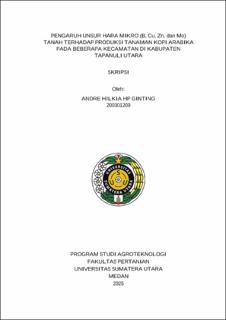| dc.description.abstract | The growth of coffee plants resembles shrubs that grow upright, coffee plants are included in two-bean plants (dicotyledons) which have taproots. This research was conducted in Pangaribuan, Simangumban, Adiankoting, Muara and Pahae Julu sub-districts in North Tapanuli Regency. This research used descriptive analytical method by taking random soil samples. Likewise, production data with the same method from 5 coffee tree samples. Micronutrient data were classified as very low, low, medium, high and very high and then regressed against the weight of 100 dry beans and productivity through multiple linear regression using IBM SPSS v.20. Micro-nutrients (B, Cu, Zn, Mo and pH) together have no significant effect on increasing the weight of 100 dry beans and productivity of Arabica coffee in Pangaribuan, Simangumban, Adiankoting, Muara, and Pahae julu sub-districts and the distribution of micro-nutrients of Arabica Coffee The acidity of soil pH in each SPL is classified as acidic, nutrient B in each SPL is classified as very high. For Cu nutrients in each SPL classified as Medium, low and very low. For the nutrient element Zn in each SPL is classified as very high and for the nutrient element Mo in each SPL is classified as low Arabica coffee in Pangaribuan, Simangumban, Adiankoting, Muara, and Pahae julu sub-districts. | en_US |


